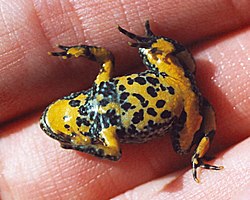Yellow-bellied toad
| Yellow-bellied toad | |
|---|---|
 |
|
| Scientific classification | |
| Kingdom: | Animalia |
| Phylum: | Chordata |
| Class: | Amphibia |
| Order: | Anura |
| Suborder: | Archaeobatrachia |
| Family: | Bombinatoridae |
| Genus: | Bombina |
| Species: | B. variegata |
| Binomial name | |
|
Bombina variegata (Linnaeus, 1758) |
|
 |
|
| Distribution of the yellow-bellied toad (in green) | |
The yellow-bellied toad (Bombina variegata) belongs to the order Anura, the archaeobatrachial family Bombinatoridae, and the genus of fire-bellied toads.
The larger of the males and females are between 35 and 55 mm, making them very small for archaeobatrachians. Their top side is grey-brown, often with washed-out, bright spots. Their under side, including the inner sides of the limbs, fingers, and toes, is grey-blue to black-blue with striking, bright yellow to orange spots or patches, usually covering more than half of the underside. Yellow-bellied toads have compact bodies - though not so flat as the related European fire-bellied toad - and a rounded snout. The pupils are heart-shaped, with the eardrums not visible. The overside has numerous warts with raised swirls.
The mating call of the males can be heard in late spring and early summer, a dull but melodic "uh... uh... uh" from their mating grounds. As the species does not have a vocal bladder, in contrast to the red-bellied toad, its call is quite gentle.
The eggs are laid in loose clutches of two to 30 eggs in grass or often in patches of plants. The eggs are medium brown on the top side, bright brown on the bottom, and measure on average 1.5 to 2.0 mm, while the jelly layer is 5 to 8 mm thick. The principal spawning time lasts from May to June.
At their highest, the edges of the fins of the 55-mm-long tadpoles reach to the middle of the body; the tail ends are rounded off. They are a dirty grey in colour and shine in all colours of the rainbow.
The yellow-bellied toad is an amphibian closely bound to areas of water. Originally, the species typically lived along brooks and rivers. It settled there dependent on the flood dynamic of temporary and continuously shifting small bodies of water. In its replacement habitats in human civilization, it is still dependent on temporary small bodies of water on loamy ground, such as tractor trails, puddles, and small ditches. Mostly, these areas are bereft of vegetation and free of competing species and predators. Through the quick heating of small bodies of water, a rapid development of spawn and larvae is guaranteed. These pioneer species can be found mainly in quarries, clay and gravel pits, and on marching grounds.
...
Wikipedia

